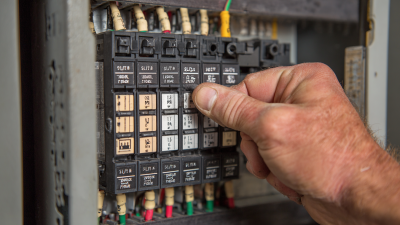7 Facts You Didn't Know About ACB Breakers: The Best Choices for Your Electrical Needs
In the realm of electrical installations, ACB breakers are pivotal in ensuring safety and functionality. According to a recent report by MarketsandMarkets, the global circuit breaker market size is projected to grow from USD 7.5 billion in 2020 to USD 10.3 billion by 2025, emphasizing the increasing reliance on sophisticated electrical protection systems. ACB breakers, more specifically, are known for their robust performance in safeguarding electrical circuits from overloads and short circuits, thereby significantly minimizing the risks of electrical fires and equipment damage. These devices not only contribute to the longevity of electrical systems but also enhance operational efficiency in various industrial applications. As we delve into seven fascinating facts about ACB breakers, we uncover why they remain the best choices for addressing diverse electrical needs across sectors.

Key Innovations in ACB Breaker Design Enhancing Electrical Efficiency
ACB breakers, or Air Circuit Breakers, have undergone significant innovations in their design, greatly enhancing electrical efficiency. These advancements focus on improving performance and reliability in high-demand environments, marking a shift in how industrial and commercial electrical systems are managed. Recent reports indicate that modern ACB designs achieve up to 30% greater energy efficiency compared to older models, contributing to lower operational costs and improved sustainability in electrical consumption.
One of the key innovations in ACB breaker design is the development of intelligent diagnostic systems. These systems monitor real-time performance, predict maintenance needs, and reduce downtime, leading to more efficient operations. Furthermore, advanced materials used in ACB construction enhance thermal management, allowing these breakers to operate effectively even in extreme conditions.
**Tips**: When selecting your ACB, consider opting for models equipped with smart technology for better monitoring and maintenance capabilities. Additionally, ensure that the breakers meet your specific energy efficiency requirements to maximize savings over time. Lastly, always consult professional guidelines and industry standards to align your choice with best practices in electrical safety and design.
7 Facts You Didn't Know About ACB Breakers: The Best Choices for Your Electrical Needs - Key Innovations in ACB Breaker Design Enhancing Electrical Efficiency
| Feature | Description | Benefit |
|---|---|---|
| Digital Trip Units | Advanced protection settings with customizable parameters | Enhanced precision in circuit protection |
| Environmentally Friendly Materials | Use of sustainable and recyclable materials | Reduced environmental impact |
| Smart Monitoring Features | Real-time monitoring and diagnostics via IoT connectivity | Improved system reliability and maintenance scheduling |
| Compact Design | Reduced physical footprint compared to traditional designs | Space-saving in electrical panels |
| Automated Testing Features | Ability to perform self-diagnosis and testing | Ensures optimal performance and safety |
| Enhanced Circuit Protection | Advanced circuit protection mechanisms to prevent overloads | Increased operational lifespan of electrical equipment |
| User-Friendly Interfaces | Intuitive control panels and displays | Simplified operation and monitoring for end-users |
Understanding ACB Breaker Ratings: What You Need to Know
When selecting an Air Circuit Breaker (ACB), understanding the ratings is crucial for ensuring safety and efficiency. ACB ratings are typically expressed in terms of their current-carrying capacity, with common ratings including 800A, 1600A, and 3200A. According to data from the International Electrotechnical Commission (IEC), the rated current determines the maximum continuous current the breaker can handle without tripping, making it essential for the intended application.
Moreover, ACBs are also rated based on their breaking capacity, which is the maximum fault current the device can interrupt without causing damage. Industry reports indicate that many modern ACBs can handle breaking capacities ranging from 25kA to 100kA, aligning with the increasing demands for robust electrical systems. Furthermore, factors such as ambient temperature and installation conditions can affect the performance of these ratings, necessitating a thorough understanding for optimal system integration. Choosing the right ACB based on these ratings can significantly enhance the reliability and safety of an electrical system while also complying with stringent industry standards.

The Role of ACB Breakers in Modern Electrical Safety Standards
The role of Air Circuit Breakers (ACB) in modern electrical safety standards cannot be overstated. ACBs are crucial for preventing overcurrent situations that could lead to electrical fires or equipment damage. They automatically disconnect the circuit when a fault is detected, ensuring the safety of not just the appliances but also the individuals using them. As homes become increasingly reliant on electricity for daily functions, the demand for reliable protection systems like ACBs has surged.
The residential circuit breaker market is projected to grow significantly, reflecting a rising awareness of electrical safety and an improvement in standards across the board. With an expected market size of USD 7.7 billion in 2024 and a growth rate of 9% annually until 2034, this sector underscores the importance of upgrading existing electrical systems. ACBs stand at the forefront of this evolution, providing essential safety features that align with contemporary electrical codes and regulations. As more consumers invest in advanced protection systems, ACBs will play an integral role in ensuring that modern homes are both safe and resilient against electrical faults.
Comparative Analysis: ACB Breakers vs. Traditional Circuit Breakers
ACB breakers, or Air Circuit Breakers, stand out when compared to traditional circuit breakers due to their superior performance and versatility. Unlike their older counterparts, ACBs can handle high current ratings, making them suitable for large industrial applications. They provide better protection against overloads and short circuits, ensuring enhanced safety in electrical systems. Additionally, the design of ACBs allows for easier maintenance and quicker trip responses, which can be crucial in preventing damage to equipment and maintaining operational efficiency.
Tips for Choosing ACB Breakers:
When selecting ACB breakers, it's essential to consider the specific electrical requirements of your application. Check the current rating and breaking capacity to ensure they align with your system’s demands. Furthermore, look for features such as adjustable trip settings and diagnostic capabilities, which can improve system reliability and help in troubleshooting.
In contrast, traditional circuit breakers may be sufficient for residential settings with lower electrical loads. However, for businesses looking to scale their operations or those dealing with heavy machinery, ACBs provide a robust solution that can adapt to fluctuating electrical loads. Prioritizing quality and adaptability when choosing between these options could lead to long-term cost savings and operational safety.
The Impact of ACB Breakers on Energy Conservation and Cost Savings
 ACB breakers, or Air Circuit Breakers, play a significant role in energy conservation and cost savings, making them an essential component for modern electrical systems. One of their primary functions is to provide protection against overload and short circuits, which not only safeguards your electrical equipment but also reduces energy waste caused by faulty circuits. By preventing potential damages, ACB breakers help maintain operational efficiency, ultimately leading to lower energy consumption and expenditure.
ACB breakers, or Air Circuit Breakers, play a significant role in energy conservation and cost savings, making them an essential component for modern electrical systems. One of their primary functions is to provide protection against overload and short circuits, which not only safeguards your electrical equipment but also reduces energy waste caused by faulty circuits. By preventing potential damages, ACB breakers help maintain operational efficiency, ultimately leading to lower energy consumption and expenditure.
Moreover, the design of ACB breakers often includes advanced features such as adjustable trip settings and real-time monitoring capabilities. These features enable users to optimize their electrical system's performance, ensuring that energy is used effectively. By integrating ACB breakers into your electrical infrastructure, you can achieve more precise control over energy distribution, leading to reduced operating costs and enhanced energy efficiency.
Embracing ACB breakers not only protects your assets but also fosters sustainable energy practices that contribute to long-term savings.
Related Posts
-

Understanding the Challenges of Miniature Circuit Breakers in Modern Electrical Systems
-

7 Essential Tips for Choosing the Right Electric Breaker for Your Needs
-

How to Choose the Right Electric Breaker for Optimal Safety and Efficiency
-

9 Essential Tips for Choosing the Right Home Circuit Breaker
-

A Comprehensive Guide to Understanding Molded Case Circuit Breakers in Industrial Applications
-

Ultimate Guide to ACB Breaker Selection and Maintenance for Optimal Performance








